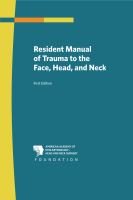

CHAPTER 3: Upper Facial Trauma
Resident Manual of Trauma to the Face, Head, and Neck
62
Act of 1996 (HIPAA) regulations. These photographs are invaluable for
planning the patient’s subsequent secondary reconstruction, if needed,
and for teaching and educational purposes. Each hospital facility
generally has guidelines and rules for operative photography; typically
hospitals ban using cell phone photography. A dedicated patient
photography camera should be used. Using digital photography has
multiple benefits, including planning the surgical procedure with the
attending otolaryngologist, documenting injuries for possible subse-
quent legal proceedings (assault and battery), planning follow-on
reconstructive procedures, and using the images for medical education.
G. Surgical Management
1. Indications for Surgery
y
y
Compressed NOE complex.
y
y
Traumatic telecanthus (widened NOE complex), unilateral or
bilateral.
y
y
Persistent epistaxis, despite local hemostatic measures.
y
y
Medial orbital fracture with entrapment demonstrated on forced
duction testing.
y
y
Fracture(s) seen on imaging studies of the floor of the frontal sinus,
which could block outflow.
y
y
Fractures of the NOE involving the medial canthal tendons.
y
y
Disruption of the lacrimal fossa and superior nasolacrimal duct.
y
y
Obvious injury to the region of the lacrimal canaliculi.
y
y
Evidence of a developing retrobulbar hematoma, which requires
urgent ophthalmologic intervention.
y
y
CSF rhinorrhea due to a fracture of the cribriform plate or posterior
wall of the inferior frontal sinus seen on imaging studies.
2. Timing of Surgical Procedures
Fortunately, with NOE complex fractures, there is usually sufficient time
before repair to adequately assess the patient’s injuries, initiate intrave-
nous antibiotic therapy, observe the patient if there is any concern
about CNS symptoms or signs, and properly prepare the operating
room for the procedures. This means that most NOE fracture patients
will not need to be operated on immediately, but may wait up to 48
hours, if needed, for the best possible approach. Only conditions such
as retrobulbar hematoma, unrelenting nasal bleeding, or a perforated
globe will require urgent surgery.
3. Surgical Exposure Options
Because most central facial fractures, such as NOE fractures, usually
have nasal bleeding as a general component, the patient may have










